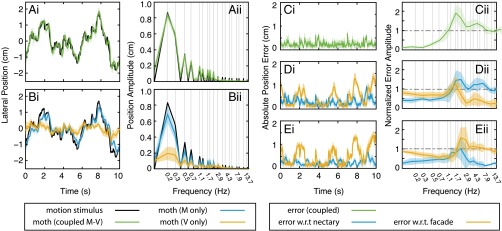Fig. 2.
Tracking performance of moths following fictive flowers under three motion stimulus conditions: (A) the flower face and nectary move through identical trajectories, (green; the coupled condition; mean and 95% confidence; n = 8), (B) the nectary oscillates while the flower face is stationary, (blue; the M-only condition; n = 8), and the nectary is stationary, (gold; the V-only condition; n = 8), while the flower face oscillates. (A, i and B, i) Time traces of tracking trials show slightly deprecated tracking in response to only nectary motion and severely impaired tracking when the flower face provides the motion stimulus. (A, ii and B, ii) The magnitude of the Fourier transform of the moth’s trajectory compared with the motion stimulus reveals that, for all conditions, the moth attends to the moving target; the spectra of moth positions show spikes in power at those frequencies that compose the input motion stimulus. (C, i) For the coupled condition, the visual and mechanosensory slips (green) are equivalent and therefore, can be simultaneously minimized. (D and E) For the M- and V-only conditions, respectively, the errors (gold) and (blue) reflect a balance of competing sensory pathways. The similarity in error signals between the two conflict conditions is notable considering the categorical differences in stimulus presentation and moth response. w.r.t., with respect to.

